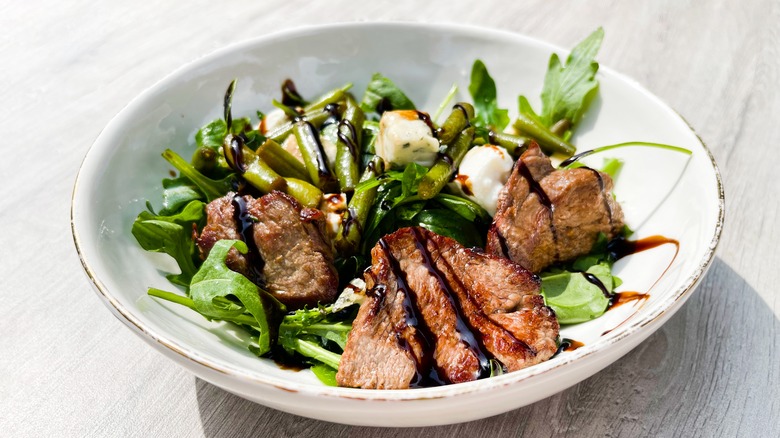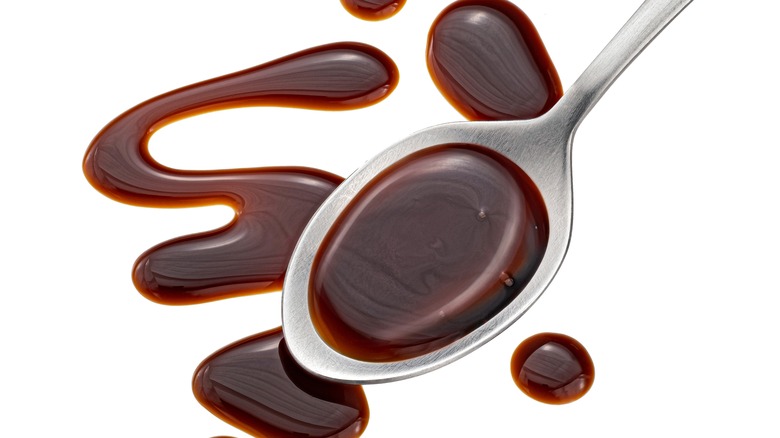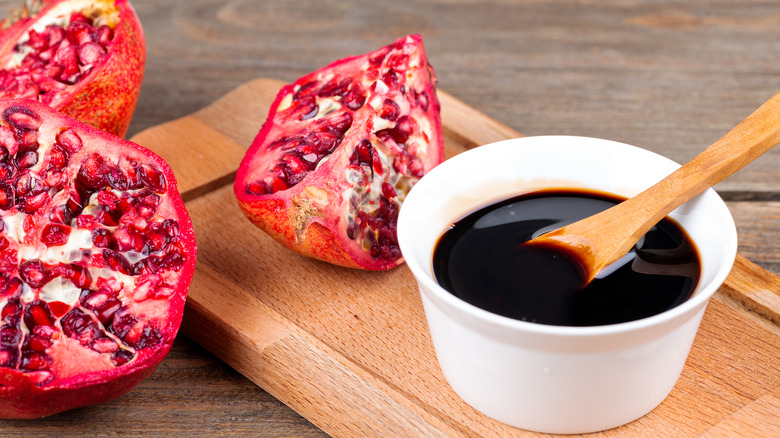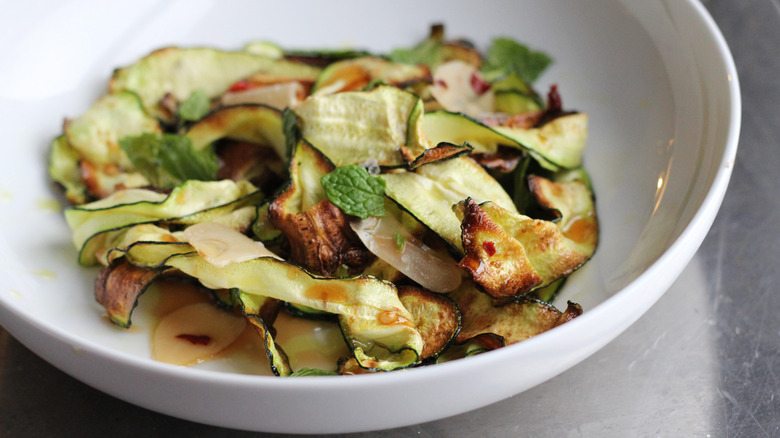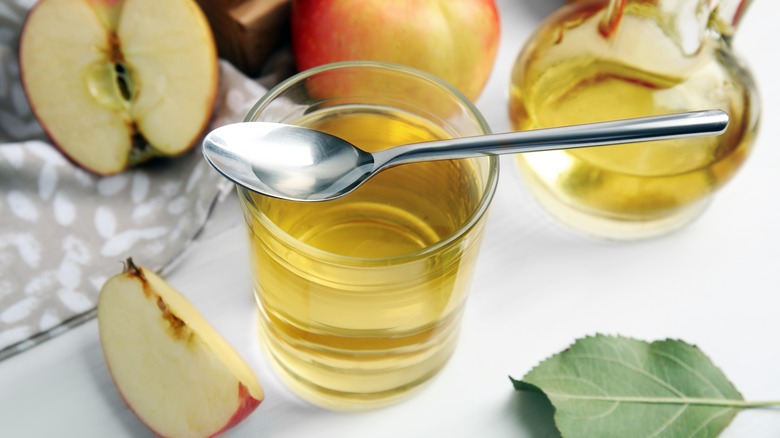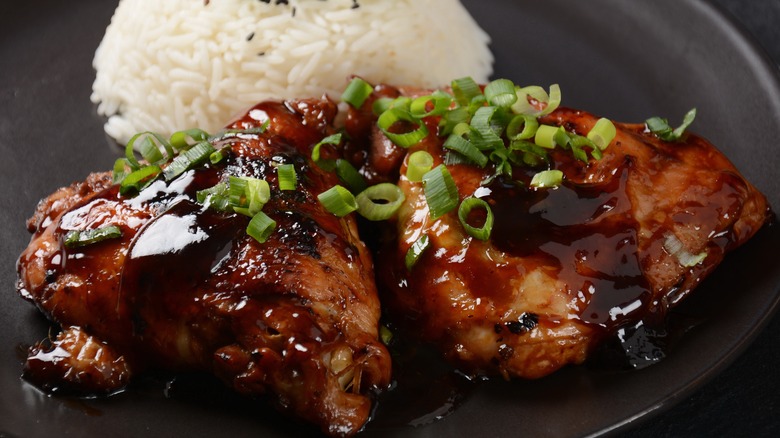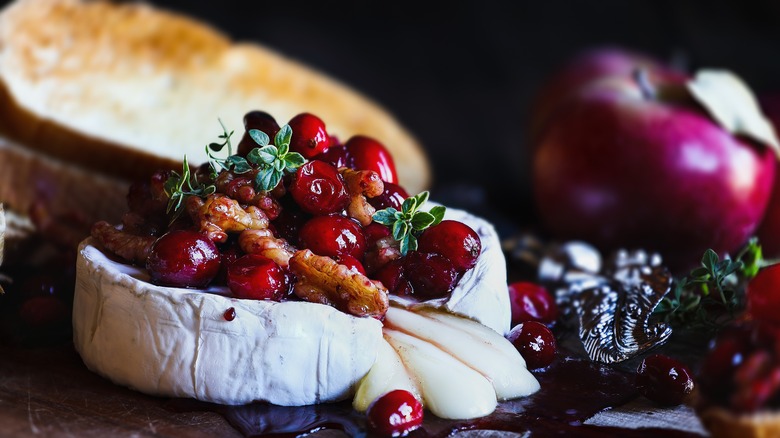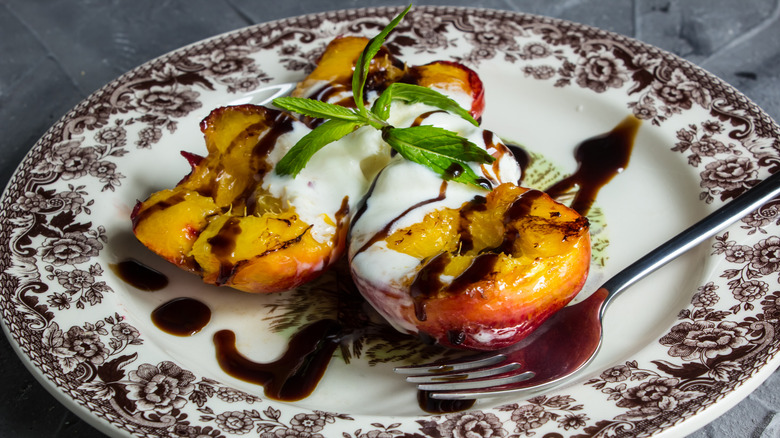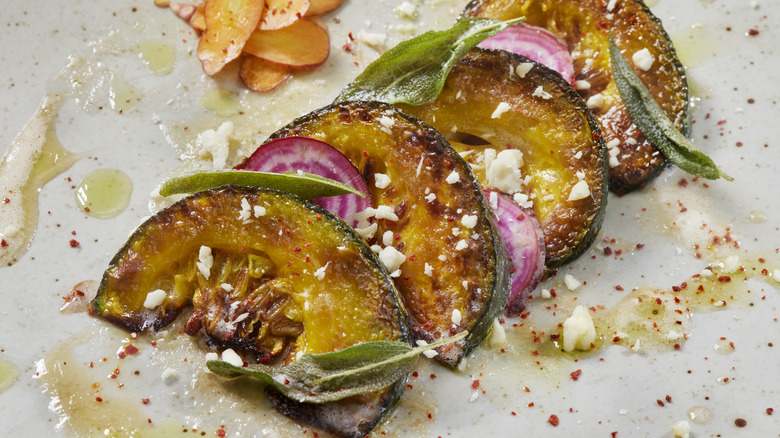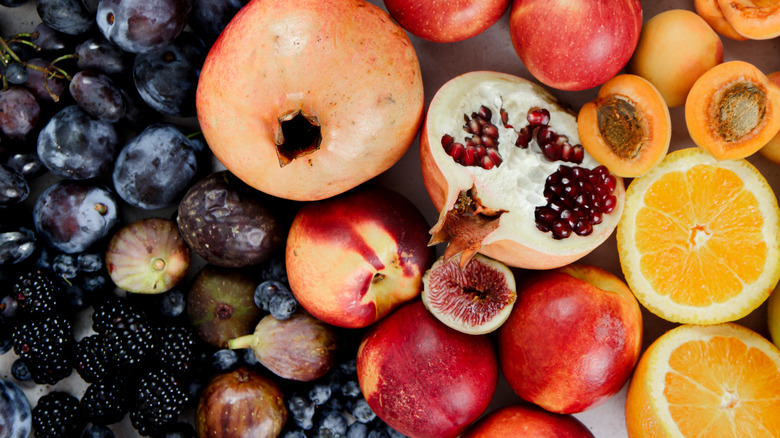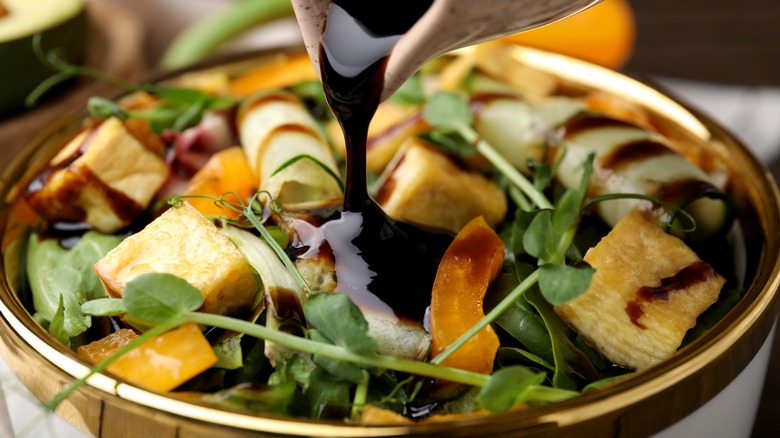What Is A Gastrique, And How Do I Cook With It?
If one thing separates professional chefs from amateur cooks, it's sauce work. Many home cooks underestimate the power of a beautiful sauce to bring together a dish or finish a plate with delicious, artistic flair. Some sauces combine all flavors of the dish in one cohesive, silky swoop, while others add another note that brightens and elevates the entire plate.
Gastriques are the latter, adding both a tart touch and a sweet note that rounds out the other flavors to make every individual ingredient sing. It's not as technical as some other French mother sauces, but it comes from the same tradition of patience and flavor/texture building that the French are famous for. Gastriques work well in sweet and savory dishes; it's an easy sauce to add to your repertoire when you need a multi-tasking finishing drizzle that goes with nearly everything. Here's what a gastrique is and how to use it in your cooking.
What is a gastrique?
A gastrique is a sweet and sour sauce typically made with caramelized sugar, vinegar, and often fruits or other flavorings. Gastriques date back to early French cuisine and have been used in cooking for hundreds of years to add a balance of sweetness and acid to dishes. The term gastrique comes from the French word meaning acid or sour; one of the earliest mentions of this technique dates to the 1650s when it was used largely as a glaze or finishing sauce for meat.
Over time, the gastrique became a staple in French cuisine, particularly in classical sauces. It is commonly used to enhance the flavor profile of dishes, providing depth and complexity to sauces and glazes. Other cultures have variations on this sauce, including a traditional sweet and sour sauce in Asian cooking and another very similar version in Italian dishes (agrodolce). The difference is the technique. Gastriques use vinegar to deglaze a pan where sugar has been caramelized, cooking it down into a syrup. Similar sauces in other cuisines use cornstarch as a thickener instead of reducing the liquid, or neglect to caramelize the sugar.
These days, gastriques are used not only in savory dishes but also as a way to add depth and complexities to all courses of a meal. They are at home on a charcuterie board, a dessert plate, and a vegetable course, making them an unexpectedly versatile addition to your culinary repertoire.
How is a gastrique made?
The basic technique to make a gastrique is to caramelize sugar, deglaze the pan with vinegar, and then reduce the entire mixture to a syrupy consistency. Generally, the ratio of sugar to vinegar is two to one. For every cup of sugar, you'll need a half cup of vinegar. Gastriques can be made with any kind of vinegar, but the most traditional is red wine.
Start by heating a heavy-bottom, high-sided saucepan over medium heat. Add the sugar to the saucepan and let it melt. Stir occasionally with a wooden spoon or spatula, and watch it carefully to ensure it does not burn. Reduce the heat if needed. Gradually, the sugar will melt and turn into a caramel color. When this happens, slowly add the vinegar while stirring constantly. The mixture will bubble up, so using the correct pan is important.
Stir until sugar and vinegar are well combined, then turn the heat to low and simmer until it reduces to syrup. Depending on how thick you want, this can take up to 15 minutes (the gastrique will continue to thicken as it cools). If you want to flavor your gastrique with herbs, spices, or fruit, add these in the last five minutes of cooking and strain after you remove the pot from the heat.
Gastrique vs agrodolce
Gastrique and agrodolce are both flavorful sauces that incorporate a balance of sweet and sour elements, but they have a couple of significant distinctions. Gastriques come from the French culinary tradition, and agradolce is an Italian sauce. Both are used in a similar manner as a sauce for meat, poultry, or fish. They can also be drizzled over a cheese plate, poured over ice cream, or used as a dressing for salads and vegetables.
The main distinction between these two sweet and tangy sauces is their technique. Gastriques are made with caramelized sugar and vinegar. The caramelized sugar provides richness and depth that is then balanced by the sharp acid of vinegar. These sauces are also commonly fortified with the addition of fruit. On the other hand, agradolce does not feature caramelized sugar. Sugar, vinegar, and other spices are combined and heated in a saucepan. This makes for a slightly lighter sauce but also opens it up to the potential for different flavor combinations that highlight seasonal vegetables, like a spring onion agrodolce used in a tangle of fresh pasta.
Choose a gastrique when you have a little extra time to carefully caramelize your sugar for a more complex final product and agrodolce when you need a sharp bite and bit of sweetness but are in a hurry.
What does a gastrique taste like?
It's hard to mistake the sharp sourness of vinegar and the familiar sweetness of sugar or honey that make up the base of a gastrique, but when combined together, something magical happens. Caramelizing the sugar lends a deeper, richer, and more complex flavor with hints of vanilla. Using honey in a gastrique also infuses the finished product with all of the distinctive notes of the honey.
Even the vinegar is transformed by the cooking process. Slowly reducing vinegar in caramel intensifies the vinegar's flavor as water evaporates. The type of vinegar used in the gastrique influences the final flavor as well. Red wine vinegar is traditional, but neglecting to explore the range of options is a mistake. Balsamic is a bold choice, but apple cider, white wine, and sherry vinegar are all excellent. The only vinegar that is entirely off the table is white vinegar. Even reduced, it lacks a flavor profile worth combining.
Further customize the finished gastrique by adding different fruits, herbs, spices, and seasonings. The combinations you use really depend on how you'll use the sauce — think adding fruits to dessert gastriques and savory herbs to those that will glaze meat or be drizzled on cheese.
Cooking with a gastrique
Gastriques can be used as an integral part of the cooking process. Unlike sauces such as a red wine reduction or a pan sauce, you don't have to wait until your meal is cooked to use a gastrique. One of the most common uses is as a marinade for meat, including beef, poultry, pork, and fish. Vinegar begins the cooking process by breaking down the fibers of the meat, and the fruit, spices, or seasoning you added to the sauce also infuse your protein.
You can also use a gastrique as a glaze during cooking. It can be challenging to grill with a sauce that has honey or sugar in it, as the risk of burning is high. Using indirect heat is key if you want to fire up the grill; otherwise, roast your protein or use the gastrique as a finishing glaze while your meat rests.
Finally, a gastrique can be fortified and expanded to create a heartier sauce. This starts by sautéeing aromatics (onions, garlic, leeks, shallots — whatever you like) and adding the gastrique and other seasonings or spices. Have cream or stock on hand to thin it slightly as it cooks, and don't forget to finish your sauce with a tablespoon or two of butter for a beautiful texture, luxurious mouthfeel, and glossy shine. Don't have that much time but still want a pan sauce made with gastrique? Deglaze the pan with stock, then add a splash of gastrique. Simmer until slightly reduced, finish with butter, and serve.
Using a gastrique at the table
One of the most popular uses of this flavorful sauce is as a complementary finishing touch. Because it can be made beforehand, it's easy to pull out at the last minute to create the illusion of a labor-intensive final product when all you really need is a fancy serving spoon.
Gastrique is glorious on a well-curated charcuterie board, cutting through the richness of the cheese and cured meats. It's also lovely on baked brie topped with fresh berries and chopped fresh mint. For plated meals, a final drizzle over meat and vegetables brings everything together and serves as a nice counterpoint to any other decadent sauces on the plate. Gastriques make a vibrant base for salad dressings, especially when infused with flavorful herbs. Consider stashing your leftover herb and herb stems so that you can use them in your gastrique.
Finally, gastriques and seafood make a powerful combination. Use a lighter vinegar when preparing a gastrique for use with fish — thinking white wine or sherry vinegar — and add herbs like tarragon and fresh dill and caper berries to mirror the sea's salty brine. Serve the sauce as an accompanying dip or spoon generously atop fish, scallops, shrimp, and crab.
Can a gastrique be used in sweet dishes?
Vinegar for dessert? Absolutely. Sour and sweet are combined because one plays off the other, adding interest to a one-note dining experience. Gastriques are not all sweet or all sour — they wobble confidently across the range of flavors, perfect for cutting through rich desserts.
The most obvious use for gastriques in dessert is ice cream. A drizzle of a richly flavored, complex balsamic gastrique seasoned with a handful of berries and maybe a clove or two turns that mid-week boring bowl of vanilla ice cream into something extraordinary. The same is true for plain cheesecake, but it goes one further. Vinegar lifts the heaviness of a slab of cheesecake and cleans the palate afterward.
For an elegant dessert that makes you look like a professional (but is actually easy to pull off), make red wine poached pears and sauce it with whipped cream and a drizzle of herby, spiced gastrique. FIavor your gastrique with fresh basil, cinnamon, and clove near the end of its cooking time, then strain and sauce your dessert right before serving.
Nutritional information about gastriques
As delicious as it is, chances are good you won't be eating spoonfuls of gastrique with every meal. A tablespoon or two will likely get you where you need to go regarding flavor. And because there is so much variation in the type of vinegar used, the amount of sugar or honey, and any additional fruit, it is challenging to get accurate counts of calories, carbs, and fats.
That said, it's safe to say that a serving of gastrique will not throw off your diet. There are fewer than 100 calories per cup, most of which come from the sugar or honey you caramelize. You might add a few calories and some carbs with the addition of fruit, but spices are calorie- and carb-free, as are fresh herbs. There is also a negligible amount of vitamins and minerals, as the amount of vinegar, herbs, and additions is so small.
One place that might bump up the calories and become problematic is using a gastrique to build a sauce. Adding heavy cream, butter, and beef or chicken stock can give this sauce a healthy calorie bump and more carbs. If you're on a weight loss journey or counting macros, stick to the basic ingredients and skip any calorie-laden additions.
Varieties of gastrique
While the basic gastrique ingredients – vinegar and sugar or honey — do a fine job of creating a sweet and tangy sauce, several varieties of gastric can be customized depending on the dish. One of the most common varieties of gastric is a fruit version made with fruit juice or puree. Oranges, berries, and mango add a fruity note to the sauce that works with all types of proteins. Herb gastriques distill the powerful, bright notes of fresh herbs and infuse your entire sauce with flavor.
Savory gastriques that use onions, garlic, or mustard are perfect for roast dishes and swirled into cream soups to lift up the heaviness and make the whole dish shine. Adding spices to this gastrique variety adds warmth and interest; the addition of citrus zest is another way to round out the flavor profile of a more complicated sauce.
Balsamic gastriques are delicious over cheeses, both hard and soft. This vinegar is more complex than some other varieties, and it's good at elevating a simple cheese plate or bowl of vanilla ice cream. It's not necessary to use a particularly expensive balsamic vinegar when making a gastrique, especially if you're going to be adding seasonings and fruit — your regular brand will do.
How to store gastrique
Along with honey, vinegar is one of those miracle ingredients that doesn't technically ever go bad. An open jar of vinegar or honey is good in perpetuity. Both may suffer in a decline in quality, but they remain safe to eat until they are gone. The main issue with the shelf life of gastrique is any additions to that vinegar or honey.
For the longest-lasting gastrique, use honey instead of sugar, spices, and dried herbs — minimize using fresh ingredients. If you use fresh fruit, your gastric can last for several weeks to a few months if stored in the refrigerator. You may notice a drop in quality as it nears the end of those months, but it should still be safe to eat. If your gastrique is nearing the end of its life, you can use it up quickly by adding fruit juice and making a fruit shrub.
Always allow your gastric to cool fully before storing it in the refrigerator in an airtight container. When you open the container, check for any signs of spoilage. These include mold, unpleasant odors, or changes to color or texture. It can be difficult to spot mold on a gastrique made with balsamic vinegar, but lighter-colored kinds of vinegar may have black spots or streaks running up from the base of your container. If you see this, discard your vinegar and wash the jar in which it was stored. It's better to throw out vinegar than run the risk of a foodborne illness.

